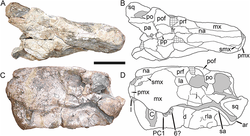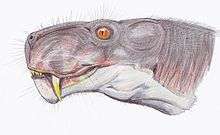Aelurognathus
| Aelurognathus Temporal range: Wuchiapingian, 260.9–254 Ma | |
|---|---|
 | |
| Holotype skull of A. tigriceps | |
| Scientific classification | |
| Kingdom: | Animalia |
| Phylum: | Chordata |
| Clade: | Synapsida |
| Order: | Therapsida |
| Family: | †Gorgonopsidae |
| Subfamily: | †Rubidgeinae |
| Genus: | †Aelurognathus Haughton, 1924 |
| Type species | |
| †Scymnognathus tigriceps Broom and Haughton, 1913 | |
| Synonyms | |
| |
Aelurognathus is an extinct genus of gorgonopsian therapsid from the Permian of South Africa.
Discovery


The type species is Aelurognathus tigriceps, originally named Scymnognathus tigriceps by South African paleontologists Robert Broom and Sydney H. Haughton in 1913, and later assigned to the new genus Aelurognathus by Haughton in 1924.
Scymnognathus parringtoni von Huene, 1950, previously assigned to Aelurognathus, is now classified as a species of Sauroctonus.[1] Aelurognathus nyasaensis Haughton, 1926 is not referable to the genus.[2]
Palaeobiology
A broken tooth beside the skeleton of a dicynodont from the Tropidostoma Assemblage Zone has been attributed to Aelurognathus, indicating that it scavenged. The bones of the back of the skeleton are the most scattered, suggesting that the Aelurognathus individuals fed on the rear of the carcass, removing the hind limbs to reach the soft underside. The small incisor teeth of Aelurognathus indicate that it was not able to crush bone but more likely stripped flesh from its prey like the modern-day wild dog Lycaon pictus. Bite marks on the bones of the skeleton were unlikely to have been made by Aelurognathus and may be an indication that another predator killed the dicynodont.[3]
Classification
Below is a cladogram from the phylogenetic analysis of Gebauer (2007):[4]
| Gorgonopsia |
| |||||||||||||||||||||||||||||||||||||||||||||||||||||||||||||||||||||||||||
References
- ↑ Gebauer E I, 2014. Re-assessment of the taxonomic position of the specimen GPIT/RE/7113 (Sauroctonus parringtoni comb. nov., Gorgonopsia). In: Kammerer C F, Angielczyk K D, Fröbisch J eds. Early Evolutionary History of the Synapsida. Dordrecht: Springer. 185−207.
- ↑ Kammerer CF. (2016) Systematics of the Rubidgeinae (Therapsida: Gorgonopsia) PeerJ 4:e1608 https://doi.org/10.7717/peerj.1608
- ↑ Fordyce, N.; Smith, R.; Chinsamy, A. (2012). "Evidence of a therapsid scavenger in the Late Permian Karoo Basin, South Africa". South African Journal of Science. 108 (11/12). doi:10.4102/sajs.v108i11/12.1158.
- ↑ Gebauer, E.V.I. (2007). Phylogeny and evolution of the Gorgonopsia with a special reference to the skull and skeleton of GPIT/RE/7113 ("Aelurognathus"? parringtoni) (PDF) (Thesis). Dissertation Universität Tübingen.
